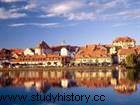 Slovenia is a small mountainous country with less than 2 million inhabitants. It is located in the Balkan Peninsula, between Italy, Austria, Hungary and Croatia. It has an outlet on the Adriatic Sea. Lovers of culture and history will find what they are looking for in Slovenia . This charming country with unsuspected resources has an astonishing cultural heritage. Museums, architecture, and cultural events qualify many Slovenian cities. Do not hesitate to come and discover its cities rich in curiosities, more than a third of which are classified as historical monuments.
Slovenia is a small mountainous country with less than 2 million inhabitants. It is located in the Balkan Peninsula, between Italy, Austria, Hungary and Croatia. It has an outlet on the Adriatic Sea. Lovers of culture and history will find what they are looking for in Slovenia . This charming country with unsuspected resources has an astonishing cultural heritage. Museums, architecture, and cultural events qualify many Slovenian cities. Do not hesitate to come and discover its cities rich in curiosities, more than a third of which are classified as historical monuments.
Ljubljana, Baroque jewel of Slovenia
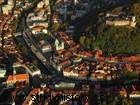 Ljubljana, capital of Slovenia, is a real gem of culture. It is marked by its old Baroque center at the foot of the Castle hill, its residences with Renaissance, Baroque and Art Nouveau facades, but also by its botanical garden (4,500 plant species and subspecies), the Tivoli park, the national gallery built in 1896, one of the oldest philharmonic orchestras in the world (founded in 1701), Saint Nicolas Cathedral without forgetting museums, theaters and art galleries.
Ljubljana, capital of Slovenia, is a real gem of culture. It is marked by its old Baroque center at the foot of the Castle hill, its residences with Renaissance, Baroque and Art Nouveau facades, but also by its botanical garden (4,500 plant species and subspecies), the Tivoli park, the national gallery built in 1896, one of the oldest philharmonic orchestras in the world (founded in 1701), Saint Nicolas Cathedral without forgetting museums, theaters and art galleries.
Numerous masterpieces of the famous architect Jože Plečnik dating from the 20th century enrich the city with:the central market, the Triple Bridge, the Church of Saint Francis, the cemetery de Zale, the athletics stadium but also the Paveurs bridge as well as the National and University Library which preserves manuscripts from the Middle Ages.
Maribor, European Capital of Culture
 Maribor European Capital of Culture 2012 and second city in the country, Maribor is animated by its many cultural events including the Lent Festival (with more than 400 artistic events) which is one of the 50 most important in Europe, and the Maribor Festival whose artistic director is the famous Australian conductor and violinist Richard Tognetti. During the latter, everyone will find Slovenian cultures and traditions mixed with artistic masterpieces.
Maribor European Capital of Culture 2012 and second city in the country, Maribor is animated by its many cultural events including the Lent Festival (with more than 400 artistic events) which is one of the 50 most important in Europe, and the Maribor Festival whose artistic director is the famous Australian conductor and violinist Richard Tognetti. During the latter, everyone will find Slovenian cultures and traditions mixed with artistic masterpieces.
Maribor will also delight all wine lovers since it has the oldest vine in the world (400 years old), a cellar where more than four million liters of wine are kept, as well as museums and galleries where the wine tradition is honored. This city also has many squares marked by history such as the main square which houses the town hall, the castle square and the freedom square from which we can observe the castle of Maribor and the regional museum, the square of Slomsek and Jewish Square.
Ptuj, medieval old town
Ptuj, the oldest town in Slovenia is worth a detour due to its protected medieval center but also its many cultural curiosities such as the monasteries (including the Dominican monastery and its collection numismatics, a lapidary museum as well as a collection of small archaeological discoveries), the tower of the city, the Saint Georges church, the monument of Saint-Florian or the monument to Orpheus...
If you go there in February, don't miss the "Kurentovaje" carnival to admire the incredible disguises of the "Kurent" who are masked characters, covered with sheepskins.
Piran, monument of Slovenian architecture
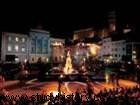 Piran, a true monument of living architecture of past centuries, saw the birth of the famous violinist Giuseppe Tartini whose place of the same name has been the main square since the 13th century. Every summer, you can take part in the Tartini Festival dedicated to the work of this famous artist. Evening concerts are then on the program. Behind the surrounding wall dating from the 7th century, you can also marvel at the old Romanesque-Gothic town hall renovated in neoclassical style (1879), or the Vénitienne (15th century), the oldest house on Place Tartini which illustrates well the Venetian Gothic architecture of Piran. Do not forget also the Saint Georges church dating from the 12th century which is the largest of the ten churches of Piran.
Piran, a true monument of living architecture of past centuries, saw the birth of the famous violinist Giuseppe Tartini whose place of the same name has been the main square since the 13th century. Every summer, you can take part in the Tartini Festival dedicated to the work of this famous artist. Evening concerts are then on the program. Behind the surrounding wall dating from the 7th century, you can also marvel at the old Romanesque-Gothic town hall renovated in neoclassical style (1879), or the Vénitienne (15th century), the oldest house on Place Tartini which illustrates well the Venetian Gothic architecture of Piran. Do not forget also the Saint Georges church dating from the 12th century which is the largest of the ten churches of Piran.
Celje, princely town
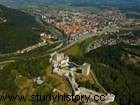 Celje, a princely city, has a wide cultural and historical heritage. We notice first of all, its imposing architecture linked to its history with among others the old castle, the Palace of the Princes dating from the 15th century and which today houses an archaeological cellar, the Saint-Daniel church, or the one of the most beautiful buildings in the city:the popular loan fund “Ljudska posojilnica”. All these buildings testify to the diversity of the past and give this city all its charm. The variety of the present and the historical links can be found in the various museums:regional museum in the "Stara grofija", Herman's lair (for children) or even the painting gallery and that of modern art preserve the traces of passed with care.
Celje, a princely city, has a wide cultural and historical heritage. We notice first of all, its imposing architecture linked to its history with among others the old castle, the Palace of the Princes dating from the 15th century and which today houses an archaeological cellar, the Saint-Daniel church, or the one of the most beautiful buildings in the city:the popular loan fund “Ljudska posojilnica”. All these buildings testify to the diversity of the past and give this city all its charm. The variety of the present and the historical links can be found in the various museums:regional museum in the "Stara grofija", Herman's lair (for children) or even the painting gallery and that of modern art preserve the traces of passed with care.
Idrija, mining town
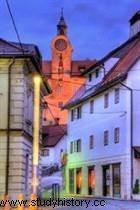 Slovenia's mining town, Idrija, has an exceptional cultural heritage. It is first known for its second mercury mine in the world, the oldest part of which "Antonijev rov" dates from 1500; but also for its expertise in bobbin lace. You can also find the international lace center where exhibitions and historical documentaries on this practice are presented. This city is also rich in monuments:the Gewerkenegg castle dating from the 16th century and whose history is preserved in its museum, the Church of the Holy Trinity or the Divje jezero lake, the first Slovenian museum in the middle of nature. This year, Idrija has been awarded "European Destination of Excellence" and may soon be included in the UNESCO World Heritage List.
Slovenia's mining town, Idrija, has an exceptional cultural heritage. It is first known for its second mercury mine in the world, the oldest part of which "Antonijev rov" dates from 1500; but also for its expertise in bobbin lace. You can also find the international lace center where exhibitions and historical documentaries on this practice are presented. This city is also rich in monuments:the Gewerkenegg castle dating from the 16th century and whose history is preserved in its museum, the Church of the Holy Trinity or the Divje jezero lake, the first Slovenian museum in the middle of nature. This year, Idrija has been awarded "European Destination of Excellence" and may soon be included in the UNESCO World Heritage List.
Slovenia therefore has a rich historical past and cultural diversity that it preserves and uses to the best of its ability. To discover.
To go further
- Ljubljana and Slovenia, by Assia Rabinowitz. The Essential, 2010.
- Le Petit Futé Slovenia. 2010.
- Slovenia:Europe in Miniature, by Sophie Massalovitch, Jean-Marie Boëlle. Editions Thalia, 2008.
See also
- Official tourist portal of the Slovenian Tourist Board
